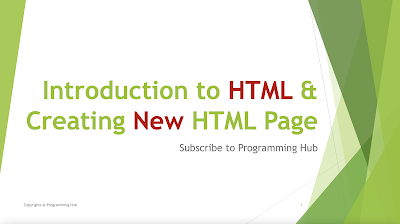- Get link
- X
- Other Apps
- Get link
- X
- Other Apps
HTML stands for Hypertext Markup Language. HTML allows web developers to structure content, define headings, paragraphs, images, and other elements of a web page, making it accessible to a wider audience. In this article, we’ll provide an introduction to HTML and guide you through the process of creating your first HTML page.
HTML Basics
HTML is a markup language that uses a series of tags to define elements on a web page. These tags are enclosed in angle brackets (< >), and the text inside the brackets provides instructions to the web browser on how to display the content. For example, the tag is used to define a paragraph on a web page, while the tag is used to insert an image.
HTML pages are created using a text editor such as Notepad, TextEdit, or Sublime Text. HTML documents have a .html file extension, and can be opened and viewed in any web browser.
Creating Your First HTML Page
To create your first HTML page, follow these steps:
Step 1: Open a text editor
Open your preferred text editor. Notepad, which comes with Windows, is a popular choice for beginners.
Step 2: Create a new file
You can create a new file by navigating to New inside File option.
Step 3: Save the file
Save the file with a .html file extension. For example, you could name the file "myfirstpage.html".
Step 4: Start with the HTML boilerplate
The HTML boilerplate is a set of code that includes the basic structure and elements of an HTML page. It’s a good starting point for creating your first web page. Here’s what the HTML boilerplate looks like:
My First Web Page
Welcome to my first web page!
This is my first paragraph.
Write the code in the text editor of your choice.
Step 5: Edit the code
Now it’s time to edit the code to add your own content. Let’s start with the tag. Change the text between the and tags to something that describes your page. For example, if you’re creating a page about your favorite hobbies, you could use:
My Favorite Hobbies
```
Next, let’s edit the tag. This tag defines a heading on the page, and should be used for the main heading of your page. Change the text between the and tags to something that describes your page. For example:
My Favorite Hobbies
Finally, let’s edit the tag. This tag defines a paragraph on the page, and should be used for the main content of your page. Change the text between the and tags to something that describes your hobbies. For example:
My favorite hobbies are reading, hiking, and playing video games.
Step 6: Save and view your page
Save your changes, and open the file in a web browser. You should see your first HTML page!
Conclusion
HTML is the foundation of the web, and is a must-know for anyone interested in web development. In this article, we’ve provided an introduction to HTML and guided you through the process of creating your first HTML page. While this is just the beginning, it’s a great starting point to dive deeper into web development and create more complex and interactive web pages.

Comments
Post a Comment